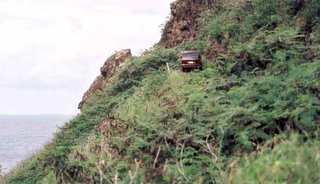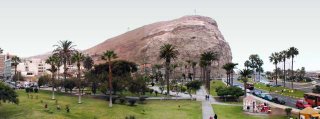Describing either road as a "highway" is a misnomer. Much of Piilani is unpaved and Kahekili is oftentimes not wide enough for two cars. This post will cover Kahekili, my favorite drive on all of Maui.
The Kahekili curves around the northwest side of the West Maui mountains. On most maps, it is a 22 mile long dotted line that connects Kapalua in West Maui with Wailuku in Central Maui. For the neophyte, I recommend going clockwise (from Kapalua to Wailuku) for the simple reason that you will, for the most part, be hugging the mountain side of the road rather than the ocean side with the sheer drops.
 Before you leave the hustle and bustle of overdeveloped West Maui, I recommend grabbing a bite at Honolua General Store, situated right next to the Ritz Carlton. The store is a relic of a bygone era. It is a rustic, old fashioned store surrounded by one of the most famous golf courses in America. It is always busy inside. You'll first notice that 95% of the customers are upper middle class vacationers who are either ordering some fancy sandwich at the deli counter or stocking up on souvenirs. Upon closer inspection, you'll notice that they are steering clear of the cafeteria style counter serving local fares such as chicken adobo, chili mac and cheese, et al.
Before you leave the hustle and bustle of overdeveloped West Maui, I recommend grabbing a bite at Honolua General Store, situated right next to the Ritz Carlton. The store is a relic of a bygone era. It is a rustic, old fashioned store surrounded by one of the most famous golf courses in America. It is always busy inside. You'll first notice that 95% of the customers are upper middle class vacationers who are either ordering some fancy sandwich at the deli counter or stocking up on souvenirs. Upon closer inspection, you'll notice that they are steering clear of the cafeteria style counter serving local fares such as chicken adobo, chili mac and cheese, et al.If you are observant, you'll notice the locals-- the hotel staff, the contractors, the gardeners, etc.-- buying these lunch plates with the obligatory two scoops of rice and scoop of macaroni salad. I highly recommend getting these heart attacks on a (styrofoam) plate and ignoring the disgusted looks of the hoity-toity set. The food is that gooood.
With your belly full, you are ready to start the journey. The drive is windy. Take your time. Tap your horn ever-so-slightly before entering blind curves. It is so quiet here, the slightest sound will get people's attention. Open all your windows, or better yet, get a convertible and take the top down. Besides enjoying the scenery, the driver should keep her eye ahead for oncoming traffic. If you are in one of the many sections where only one car will fit, you may have to stop and back up to allow the car approaching you to pass.
If the drive gets a little too intense and you need a break, stop off at the Kaukini Gallery & Gift Shop. It is at the top of a hill (how about that for vague directions?!). You can't miss it. Although I'm not one to buy stuff at galleries, there is a lot of cool stuff inside to just look at.
 A little bit further is the little sleepy village of Kahakuloa. It is at the end of a valley abutting the sea. Taro is still grown here. To say the place is slow faced and tranquil is an understatement. I oftentimes imagine this is what Hawaii would be like if there was no such thing as tourism.
A little bit further is the little sleepy village of Kahakuloa. It is at the end of a valley abutting the sea. Taro is still grown here. To say the place is slow faced and tranquil is an understatement. I oftentimes imagine this is what Hawaii would be like if there was no such thing as tourism.
The highlight in town for me is Julia's banana bread stand. This green wooden stand with benches cannot be missed. Every time I go to Maui, I stop by here to pick up two orders of banana bread. They are always warm and they are without a doubt the best in the world. Even if you decide to drive by the stand without stopping, Julia will still smile and wave at you.
As you approach Wailuku, near the 7 mile marker, you will find a paved one lane road going inland. Drive up about a mile and you'll be at the Waihe'e Ridge trail's trailhead. This 2.5 mile trail takes you through a pasture, a cool forest, and ends at a 2,500 foot peak with a picnic table and bench. There, through the fog, you'll see sightseeing helicopters flying BELOW you, through the chasms of the West Maui mountains. Afar, you can see Wailuku and Kahului. It is an exhilarating and quick (2 hours total) hike. Be forewarned that the steep, paved portion near the trailhead is very hard on the knees, especially when you are walking downhill.
CKY




























